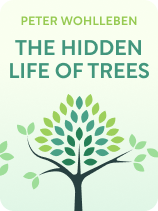

This article is an excerpt from the Shortform book guide to "The Hidden Life of Trees" by Peter Wohlleben. Shortform has the world's best summaries and analyses of books you should be reading.
Like this article? Sign up for a free trial here.
Do trees speak? What’s the “wood wide web”? Why do trees produce different smells?
According to forester Peter Wohlleben in The Hidden Life of Trees, trees have their own unique form of communication. Trees can warn one another of dangers, ask for help, and may even be able to sense their surroundings through a form of echolocation.
Keep reading to learn more about how trees communicate.
The Language of Trees
Want to know how trees communicate? In his book, Wohlleben argues that trees not only support each other, but they speak with each other as well. While trees don’t use human-like languages, they still have ways of talking to each other. Wohlleben explains that trees use chemical signals, smell, and maybe even sound to communicate with each other.
Electrochemical Communication
According to Wohlleben, one of the ways in which trees communicate is through chemical signals and electrical impulses. Research has shown that trees can warn each other of potential dangers through a vast underground network of fungi that connect the roots of trees and other plants in a forest, playfully termed the “wood wide web.” Through these networks, trees send chemical compounds that act as messages, conveying information about threats like insects, drought, and other environmental stressors. This means that if one tree detects an insect infestation, it can send out a chemical alert to its neighbors, allowing them to prepare and defend themselves.
(Shortform note: While it’s unclear who coined the term “wood wide web,” it’s often associated with the research of Suzanne Simard. While writing her Ph.D. thesis on the fungal links between Douglas fir and paper birch in the forests of British Columbia, Simard used isotopic tracing techniques and radioactive carbon tracers to trace the movement of nutrients and carbon within the fungal network connecting trees. This groundbreaking work provided evidence of an intricate underground network facilitated by mycorrhizal fungi, the “wood wide web,” through which trees actively exchange chemicals and resources. Simard’s research revolutionized our understanding of forest ecology.)
But the communication doesn’t stop at chemical compounds, writes Wohlleben. Research indicates that trees also use electrical impulses to relay information. While these impulses travel at a pace of a third of an inch per second—a speed that may seem almost glacial compared to the rapid communication in our own bodies—it is still an efficient way for trees to exchange vital information over distances.
(Shortform note: Edward Farmer, a researcher at the University of Lausanne in Switzerland, has conducted extensive studies on the presence of electrical pulses in plants. His research suggests that the voltage-based signaling system is remarkably similar to that found in animal nervous systems. While his research doesn’t suggest that plants possess neurons or brains analogous to animal structures, it does highlight complexities of plant physiology that humans still don’t fully understand.)
Olfactory Communication
Wohlleben contends that another way trees communicate with each other is through smell. By releasing and detecting scents in their surroundings, trees can send out warnings and solicit help.
When trees are attacked by hungry herbivores or insects, they release scent compounds or gases that warn other trees of the threat. For example, when giraffes begin feeding on an African acacia tree, the tree responds immediately by increasing the production of a toxic compound called tannin to make its leaves less palatable. At the same time, the tree releases a cloud of ethylene gas as a warning to neighboring acacias. Upon detecting this ethylene gas, nearby acacia trees pre-emptively increase their own tannin production, even before the giraffes reach them. This quick olfactory communication helps protect the trees from being overly grazed by the herbivores.
(Shortform note: How do African acacia trees detect chemical signals in their environment? While trees don’t “smell” like animals do, they can detect volatile organic compounds (VOCs) released by other plants or invading pests. Plant cells have receptor proteins on their surfaces designed to interact with specific molecules. When the right VOC comes into contact with a receptor, it triggers a cascade of chemical responses within the cell. Unlike animals, plants respond to odors more slowly, as the compounds only gradually accumulate within their cells.)
Wohlleben says that trees also release specific scents to attract beneficial insects to aid in pollination and protection. For instance, when certain trees are attacked by pests, these trees can emit pheromones that attract the natural predators of those pests. While this might seem like a chemical defense mechanism, it’s also a form of olfactory communication, signaling to beneficial species that there’s a food source (the pests) available. For example, when trees sense they’re being attacked by leaf-eating caterpillars, the trees are able to attract parasitic wasps who lay their eggs inside the caterpillars.
(Shortform note: Research suggests that we can use plants’ olfactory communication to improve agricultural practices. The VOCs produced by plants have the potential to attract beneficial insects that prey on common agricultural pests, producing a natural and sustainable method of pest control. By identifying and understanding the VOCs plants produce, scientists hope to use this knowledge to encourage the growth of beneficial insect populations on farms, thereby reducing the need for chemical pesticides. This approach not only benefits the environment but can also lead to healthier soils and crops.)
Auditory Communication
Wohlleben also touches upon research that suggests that trees might communicate using sound. Researchers have discovered that the roots of plants, including trees, produce a crackling noise at a frequency of 220 Hz. While the reason behind these noises isn’t clear, some evidence suggests they might be related to cell-to-cell communication or the movement of water and sap. More intriguingly, there’s evidence that trees and plants can respond to these sounds. In controlled experiments, researchers have found that roots will often grow toward a source of continuous sound at the 220 Hz frequency. This suggests that trees might be using these sounds either to communicate with each other or to sense their environment.
(Shortform note: According to one study, plants are more likely to emit high-frequency sounds when they’re stressed. The noises also change depending on the types of stressor the plant is experiencing. For example, a machine learning algorithm was able to distinguish between the sounds of a cut plant and the sounds of a dehydrated plant 70% of the time.)
The exact mechanism underlying sound communication among trees is still a matter of research and debate, says Wohlleben. Some speculate it could be a form of echolocation, helping trees sense the layout of their surroundings. Others think it might be a more direct form of communication, with trees sending signals to each other about environmental conditions, threats, or other vital information. While this research is still in its infancy, as Wohlleben points out, every new discovery about trees challenges our previous understanding and shows just how complex and interconnected forest ecosystems really are.
(Shortform note: To better understand trees’ auditory communication, biologist David Haskell used advanced recording equipment to capture the subtle, often overlooked sounds produced within the cellular structure of trees. For instance, he recorded the sounds of water being pulled up through the tree’s transport tissue, the hissing noise caused by internal respiration, and even the minuscule vibrations caused by insect interactions. Haskell refers to the collection of these sounds as a tree’s “song.” Haskell’s work has opened up a new avenue for ecological monitoring, where deviations in the song of a tree could provide potential early warning signs of environmental stress or disease.)

———End of Preview———
Like what you just read? Read the rest of the world's best book summary and analysis of Peter Wohlleben's "The Hidden Life of Trees" at Shortform.
Here's what you'll find in our full The Hidden Life of Trees summary:
- The characteristics of trees and forests that make them so remarkable
- How trees in old-growth forests cooperate and communicate
- Actionables that humans can take to help protect the forests






